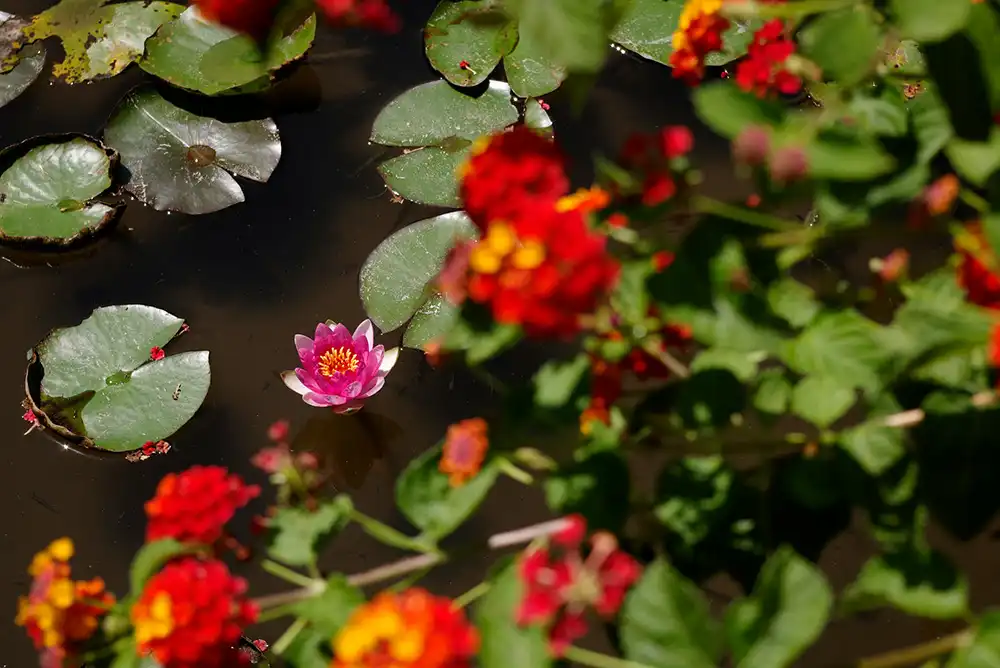
01 Nov Why Are My Aquatic Pond Plants Dying?
Dying pond plants are usually a sign of water quality issues, poor placement, or stress from seasonal and biological factors.
By Shawn Schroeder
As a pond service technician with over twenty years of experience, I have seen many Los Angeles pond owners struggle with declining plant health. Healthy aquatic plants are crucial for maintaining water balance, promoting koi health, and enhancing pond beauty. When they start to die, it is usually a symptom of an underlying issue. Below, I will break down the most common reasons your pond plants may be failing—and what you can do to bring them back to life.
Poor Water Quality
The primary reason pond plants fail is an imbalance in water chemistry. High ammonia, nitrite, or nitrate levels stress roots and leaves, while low oxygen suffocates submerged plants. Aquatic plants require a stable pH (ideally between 6.5 and 7.5) and oxygen levels of around 6% for koi ponds. Without proper filtration systems, waste and debris build up, suffocating both koi and plants.
Sunlight Imbalance
All plants need sunlight, but too much exposure—especially during scorching Los Angeles summers—can burn floating leaves like water lilies. On the other hand, ponds shaded too heavily by trees or structures may not provide enough light for oxygenators like hornwort or anacharis. Aim for four to six hours of direct light daily to strike the right balance.
Overcrowding and Koi Damage
Plants compete with each other and with koi. Overcrowding reduces nutrient availability, while koi often nibble on tender leaves and uproot shallow-rooted plants. Providing plants with proper spacing and using planting baskets can help protect their roots. Hardy species, such as lotus and iris, tend to withstand koi activity better.
Incorrect Planting Depth or Containers
Every species has a preferred depth. Water lilies, for example, need 12–24 inches of water over their crown, while bog plants like cattails belong near pond edges. Planting too deep suffocates roots; too shallow leaves them vulnerable to heat and koi. Using proper containers with aquatic soil helps stabilize plants and ensures steady growth.
Seasonal Stress
Los Angeles weather is unique: mild winters, but hot, dry summers with sudden temperature shifts. Rapid heat spikes can shock tender plants, while cooler nights in spring and fall can slow growth. Seasonal thinning, fertilization, and relocation of tropical species indoors during colder nights can prevent die-off.
Root Rot and Disease
Just like terrestrial plants, pond plants are susceptible to fungal and bacterial infections. Yellowing leaves, mushy stems, and foul odors often indicate root rot. This usually occurs when the soil is too compact or when water circulation is poor. Regular pond cleaning helps reduce pathogens, and in severe cases, plants may need to be replaced.
Algae Competition
Excessive algae starves plants of both light and nutrients. String algae can smother submerged oxygenators, while floating algae clouds the surface and reduces sunlight penetration. Installing a UV filter helps control algae growth, while regular maintenance prevents algae from overtaking the pond.
Nutrient Deficiency or Improper Fertilization
Most pond plants thrive on natural koi waste; however, additional nutrients may be needed at times. Fertilizer tablets designed for aquatic plants can be added in spring and summer. Over-fertilization, however, can trigger algae blooms, so moderation is key.
Chemical Sensitivity
Pond treatments for algae, parasites, or water clarity can harm sensitive plants. Copper-based therapies, in particular, are toxic to many species. Always use pond-safe products and consult a professional if you’re unsure.
Conclusion
When aquatic plants begin to die, the solution is almost always tied to water quality, placement, or the balance between koi and plants. With the right maintenance routine—regular water testing, proper planting techniques, seasonal adjustments, and protection against algae—your plants will thrive. If you are struggling with plant health, we provide and install fish-friendly pond plants that are well-suited for koi ponds in Los Angeles County.
About Author
Shawn Schroeder is the founder and owner of Aquatic Gardens. He is a pond service technician with over 20 years of experience in the business. Shawn has extensive experience in koi health, aquatic plant care, pond filtration, and the chemical and biological compounds of pond water. For Shawn, pond service is not just a business, but a passion as well. Shawn has taken a great interest in all fish, particularly koi, and pond construction and maintenance since he was a young boy, digging holes in his parents’ backyard and filling them with water. To those who know him, Shawn is “the pond guy.”



